Kashyapa Shilpa-shastra (study)
by K. Vidyuta | 2019 | 33,520 words
This page relates ‘Fourteen types of Samashra (Square) Mandapas’ of the study on the Kashyapa Shilpa-shastra (in English) with special reference to the characteristics of Prakara (temple-components), Mandapa (pavilions) and Gopura (gate-house). The Silpa-Sastras refers to the ancient Indian science of arts and crafts, such as sculpture, architecture and iconography. This study demonstrates the correlatation between ancient Indian monuments (such as temples and sculptures) and the variety of Sanskrit scriptures dealing with their construction.
4. Fourteen types of Samāśra (Square) Maṇḍapas
(i). First maṇḍapa
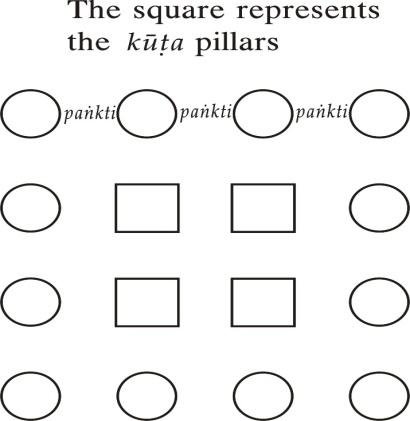 This maṇḍapa must be endowed with 3 paṅktis (parts), 16 pillars and 16 alpanāsis; in the midst it must have a kūṭa (a tower like structure on the roof). It may have entrances in the four directions or doors in any desired direction or 2 jālakas in the eight directions.
This maṇḍapa must be endowed with 3 paṅktis (parts), 16 pillars and 16 alpanāsis; in the midst it must have a kūṭa (a tower like structure on the roof). It may have entrances in the four directions or doors in any desired direction or 2 jālakas in the eight directions.
Further, on the outside, stairs with decorated toraṇas (arches) or stairs without toraṇas must be designed (XLIV. 29-31):
paṅktitrayasamāyuktaṃ ṣoḍaśastambhasaṃyutam |
kalālpanāsikopetaṃ madhye kūṭaṃ tu eva vā ||
maṇḍitaṃ vātha sarvatra caturdvārayutaṃ tu vā |
iṣṭadigdvāramevaṃ vā dvayajālakakoṣṭhadik ||
bāhye sopānasaṃyuktaṃ citraṃ tattoraṇādibhiḥ |
toraṇādi vihīnaṃ vā kalpyaivaṃ prathamaṃ bhavet ||
(ii). Second maṇḍapa
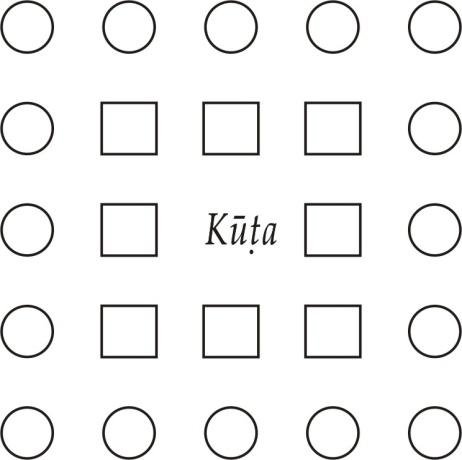 The maṇḍapa must be with the extent of 4 paṅktis; entrances can be in any desired direction; and in the eastern and western side, there must be an extension of 2 or 1 paṅkti (XLIV. 32):
The maṇḍapa must be with the extent of 4 paṅktis; entrances can be in any desired direction; and in the eastern and western side, there must be an extension of 2 or 1 paṅkti (XLIV. 32):
caturbhaktyā viśālaṃ tu iṣṭadigdvārasaṃyutam |
pūrvāpare dvipaṃktyaikabhaktyā vistṛtanīvrakam ||
The centre of this maṇḍapa, must be designed without any pillars but with 2 paṅktis and an upright kūṭa. The maṇḍapa must have 24 pillars, 20 nāsikās, doors and stairs with ear or plough-shaped walls.
Furthermore, it must have 8 pañjaras (a niche in the hāra-varga) (43. 49-50)[1] :
madhyasthāṃghriṃ parityajya ūrdhve kūṭaṃ dvibhaktikam |
bhānudviguṇasaṃkhyāṃghriyuktaṃ viṃśatināsikā ||
dvādaśāsu ca sopānaṃ karṇe lāṃgala bhittikam |
vasupañjarasaṃyuktaṃ dvitīyaṃ maṇḍapaṃ bhavet ||
(iii). Third maṇḍapa
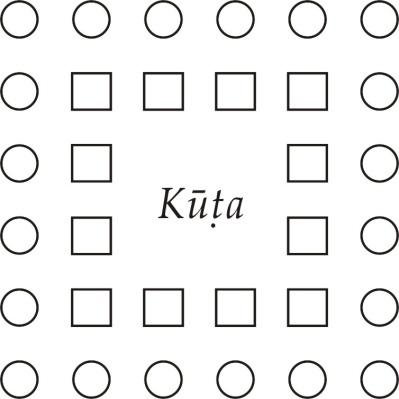 This must have 5 paṅktis and should be square-shaped; its centre must have a kūṭa with a measure of 3 parts and the maṇḍapa must be surrounded by 32 pillars (XLIV. 34):
This must have 5 paṅktis and should be square-shaped; its centre must have a kūṭa with a measure of 3 parts and the maṇḍapa must be surrounded by 32 pillars (XLIV. 34):
pañcabhaktyā yugāśraṃ tu madhye kūṭaṃ tribhāgayā |
maṇḍapaṃ paritoṃśena dvātriṃśaccaraṇānvitam ||[2]
The maṇḍapa must consist of 24 nāśikās, 8 pañjaras and entrances in the desired directions.
In those directions where there is no entrance, walls must be constructed; in the places where there is a door, it must be endowed with a staircase embellished with ornamentations and the walls must be adorned with kumbhalatā and other components (XLIV. 35-6):
bhānudviguṇanāsāḍhyaṃ pañjarāṣṭa kasaṃyutam |
iṣṭadigdvārasaṃyuktaṃ dvārānyatraiva kuḍyakam ||
dvārasthane tu sopānaṃ sarvālaṃkārasaṃyutam |
kuḍyaṃ kumbhalatādyaistu bhūṣitaṃ tu tṛtīyakam ||
(iv). Fourth maṇḍapa
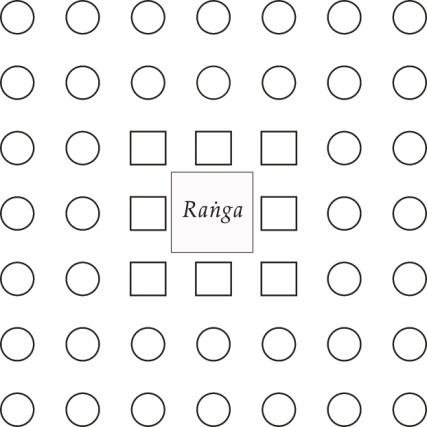 The fourth type of maṇḍapa of square-shape should constitute of 6 paṅktis. In its midst, the kūṭa must be of 2 parts with 8 pillars and in the centre there must be a raṅga (stage).
The fourth type of maṇḍapa of square-shape should constitute of 6 paṅktis. In its midst, the kūṭa must be of 2 parts with 8 pillars and in the centre there must be a raṅga (stage).
It may have four entrances in the four directions or an entrance in the desired direction; it must have 2 paṅktis and must extend to the paṅkti's measure (XLIV. 37-8):
caturaśraṃ tu ṣaḍbhaktyā madhye kūṭaṃ dvibhāgayā |
tatkūṭamaṣṭapādāḍhyaṃ madhye raṅgasamāyutam ||
caturdvārasamāyuktaṃ iṣṭadigdvārameva vā |
dvibhaktavistṛtaṃ caiva bhaktyā nīvraṃ samāyutam ||[3]
The maṇḍapa must also have bhadras (porticos) in all the eight directions or in the main four directions.
Moreover, 48 pillars must be erected in this endowed with 24 alpanāsis; walls ornamented with kumbhalatās and 8 toraṇas are also to be designed here (XLIV. 39-40):
iṣṭadigbhadrasaṃyuktaṃ caturdigbhadrameva vā |
catvāriṃśati cāṣṭāṃghriyuktaṃ vā tatra yojayet ||
caturviṃśālpanāsāḍhyaṃ kuḍyaṃ kumbhalatānvitam |
toraṇāṣṭakasaṃyuktaṃ caturthaṃ maṇḍapānvitam || 1 8
(v). Fifth maṇḍapa
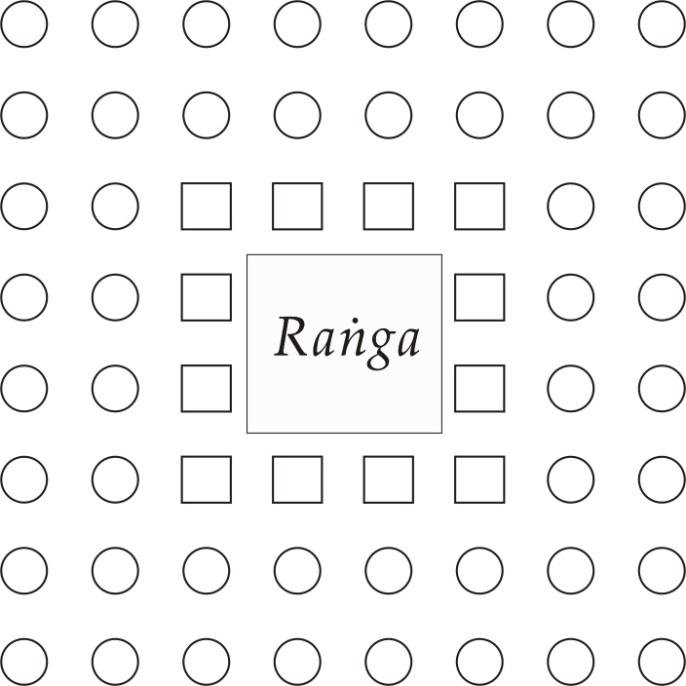 The next type is also of square shape with 7 paṅktis and 60 pillars. In its midst a kūṭa of 9 parts well embellished with gems must be designed. The maṇḍapa must be constituted with 32 alpanāsis, bhadras in the 4 directions and a mukhabhadra (front portico) that protrudes, with a measure of one-third part.
The next type is also of square shape with 7 paṅktis and 60 pillars. In its midst a kūṭa of 9 parts well embellished with gems must be designed. The maṇḍapa must be constituted with 32 alpanāsis, bhadras in the 4 directions and a mukhabhadra (front portico) that protrudes, with a measure of one-third part.
The centre of the maṇḍapa should have a raṅga, walls in the desired directions and must be well decorated (XLIV. 41-3):
caturaśraṃ tu saptāṃśaṃ ṣaṣṭhyaṃghrikasamāyutam |
navabhāgena tanmadhye kūṭaṃ vā maṇḍitāṃ kaṇam ||
dvātriṃśadalpanāsāḍhyaṃ caturdigbhadrasaṃyutam |
tribhāgaikāṃśavistāraṃ nirgamaṃ mukhabhadrakam ||
madhye raṅgasamopetaṃ iṣṭadikku ḍyasaṃyutam |
sarvālaṃkārasaṃyuktaṃ pañcamaṃ parikīrtitam ||[4]
(vi). Sixth maṇḍapa
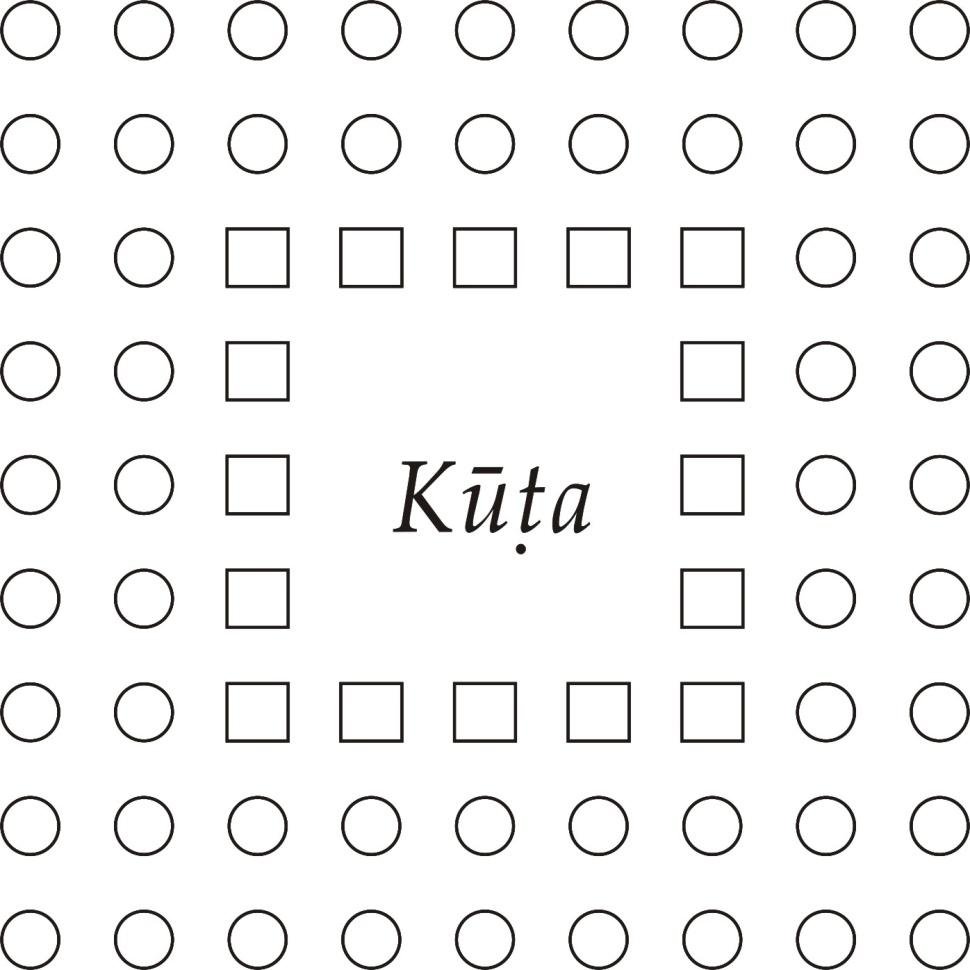 This square maṇḍapa is adorned with 80 pillars[5] and in its centre an upright kūṭa with 4 paṅktis is to be built.
This square maṇḍapa is adorned with 80 pillars[5] and in its centre an upright kūṭa with 4 paṅktis is to be built.
There must be entrances in the four directions and in one part of the centre a kūṭa must be constructed with all embellishments (43. 61-2)[6] :
yugāśramaṣṭabhaktyā tu aśīticaraṇānvitam |
caturbhāgena tanmadhye hyūrdhvakūṭaṃ prakalpayet ||
caturdigdvārasaṃyuktaṃ madhyaikāṃśena kūṭakam |
sarvālaṅkārasaṃyuktaṃ ṣaṣṭhamaṃ maṇḍapaṃ bhavet ||
(vii). Seventh maṇḍapa
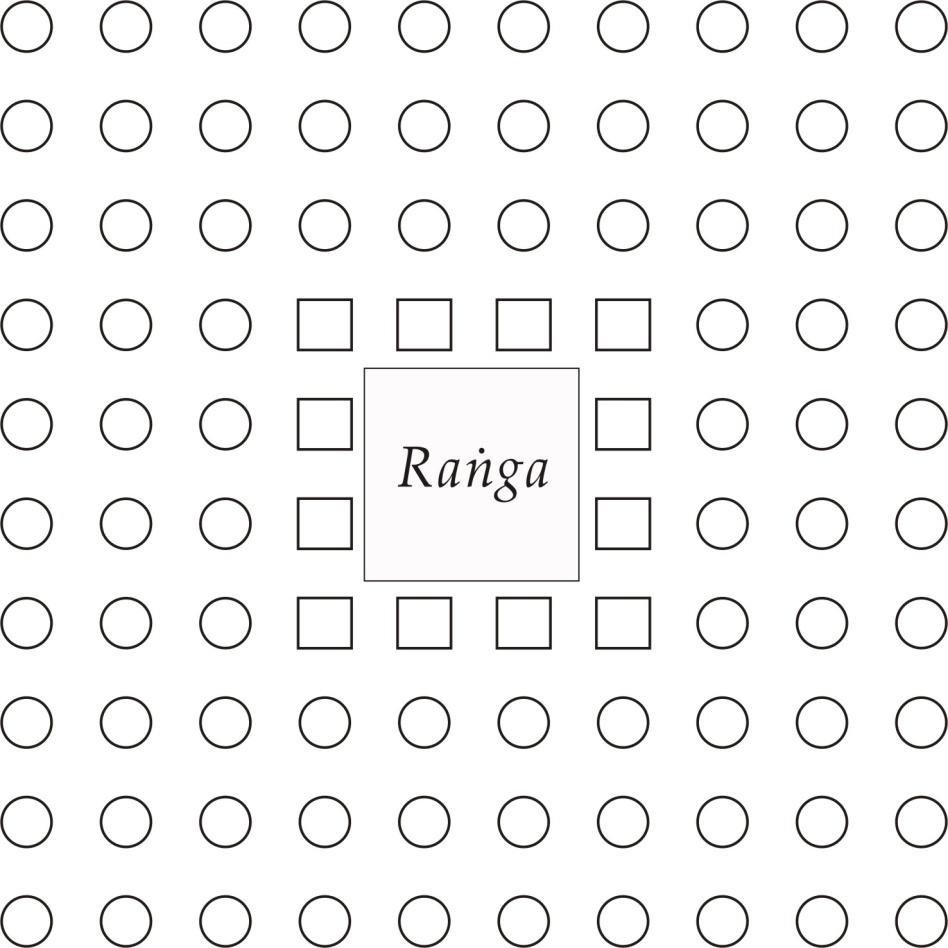 The seventh maṇḍapa consists of 9 paṅktis, 100 pillars, 4 bhadras measuring one-third aṃśa each and is square shaped. It may have entrances in the four cardinal directions or an entrance in the desired direction and in the front it must have a staircase which should be broad measuring 5 parts.
The seventh maṇḍapa consists of 9 paṅktis, 100 pillars, 4 bhadras measuring one-third aṃśa each and is square shaped. It may have entrances in the four cardinal directions or an entrance in the desired direction and in the front it must have a staircase which should be broad measuring 5 parts.
To the middle of the maṇḍapa a raṅga must be contrived along with 48 nāśikās and overall it must be well embellished (43. 63-5)[7] :
navabhaktyā yugāśraṃ tu śataṃ pādasamanvitam |
guṇāṃśakāṃśaviṃśaṃ tu nīvrabhadraṃ caturthakaḥ ||
caturdvārasamāyuktaṃ iṣṭadigdvārameva vā |
mukhe sopānamagnyaṃśaiḥ vyāsadīrghasamanvitam ||
madhyaraṅgasamāyuktaṃ ṣaḍaṣṭau nāsikānvitam |
sarvālaṅkārasaṃyuktaṃ saptamaṃ maṇḍapaṃ bhavet ||
(viii). Eighth maṇḍapa
The eighth square maṇḍapa has 10 paṅktis, 112 pillars and in the middle a kūṭa of 8 + 1 parts is to be built. Above the kūṭa, a projecting antarāla must be constructed.
Also, staircases facing east along with bhadras should be designed and thus the maṇḍapa must be well ornamented (XLIV. 47-9ab):
caturaśraṃ daśāṃśaṃ tu bhānvadhikaśatāṃghrikam |
madhye caivāṣṭadigbhāga madhyakūṭasamāyutam ||
kūṭoparinīvratāṃśe antarālaṃ prakalpayet |
prāgvanmukhena sopānaṃ diśi bhadrasamanvitam ||
sarvālaṃkārasaṃyuktaṃ aṣṭamaṃ maṇḍapaṃ bhavet |[8]
(ix). Ninth maṇḍapa
This maṇḍapa, square in shape with 11 paṅktis has a kūṭa of 5 parts, staircase in the frontage and bhadras in the desired directions. Entrances or walls until the desired part are also to be raised.
This maṇḍapa must also be endowed with all alaṅkāras (XLIV. 49cd-51ab):
rudrabhaktyā yugāśraṃ tu madhye agnyaṃśena kūṭakam ||
mukhe sopānasaṃyuktaṃ iṣṭadigbhadrasaṃyutam |
dvāramatraiva kuḍyaṃ vā iṣṭabhāgāvasānakam ||
sarvālaṃkārasaṃyuktaṃ navamaṃ maṇḍapaṃ bhavet |
(x). Tenth maṇḍapa
The tenth type of square maṇḍapa should be endowed with 12 paṅktis, with a kūṭa of 2 parts in the centre; outside the maṇḍapa, an alinda (corridor) must be featured in 1 part. 8 times the measure of the corridor, an outward path must be laid in the 4 directions.
Also, it should have 168 pillars, a central raṅga and should be completely decorated (XLIV. 51cd-53):
dvādaśāṃśe yugāśraṃ tu madhye dvyaṃśena kūṭakam ||
maṇḍapasya tu bāhye tu aṃśenālindamiṣyate |
caturdvyaṃśena tu vistāraṃ niṣkrāntaṃ syāccaturdiśi ||
sāṣṭaṣaṣṭiśataṃ pādaṃ madhyaraṅgetu kalpayet |
sarvālaṃkārasaṃyuktaṃ daśamaṃ maṇḍapaṃ bhavet ||
(xi). Eleventh maṇḍapa
Square in shape, this type has 13 paṅktis, a kūṭa of 3 parts in the middle, walls in the desired directions and bhadras in the cardinal directions. A mukhabhadra of 9 parts must be built in the front side; also it must consist of 192 pillars.
Moreover the maṇḍapa should be well adorned with decorations like the toraṇas and the jālakas (43. 73-5)[9] :
yugāśraṃ trayodaśāṃśena madhye'gnyaṃśena kūṭakam |
iṣṭadikku ḍyasaṃyuktaṃ caturdigbhadrasaṃyutam ||
prāṅmukhe nandabhāgena mukhabhadraṃ prakalpayet |
dvinavatyadhikaśatasaṃkhyākāṃghri samanvitam ||[10]
toraṇairjālakaiścānyaiḥ alaṃkārasamanvitam |
sarvālaṃkārasaṃyuktaṃ rudrāṃśaṃ maṇḍapaṃ bhavet ||
(xii). Twelfth maṇḍapa
This maṇḍapa consists of 14 parts and is square in shape; it has a kūṭa of 2 parts and is constituted with 216 pillars. Also, this has walled bhadras numbering more than 9, in the four directions and may have any desired number of paṅktis.
Thus the twelfth maṇḍapa must be well embellished with all ornamental structures (43. 76-8ab)[11] :
manubhāgairyugāśraṃ tu madhye dvyaṃśena kūṭakam |
vedādhikyaṃ tu viṃśāṃśaṃ dviśataṃ caraṇānvitam ||
maṇḍapaṃ kuḍyasaṃyuktaṃ caturdigbhadrasaṃyutam |
nandādi bhadrasaṃyuktaṃ iṣṭabhaktyā viśeṣataḥ ||
sarvālaṃkārasaṃyuktaṃ dvādaśaṃ maṇḍapaṃ bhavet |
(xiii). Thirteenth maṇḍapa
Thirteenth type of the square maṇḍapa extends in length and breadth to the measure of 15 paṅktis; to its centre in 3 parts is constructed an upright kūṭa. A mukhabhadra measuring 3 parts in length, walls in desired directions and pillars in other places are constructed. All the above should be well ornamented with toraṇas and jālakas.
Moreover, the maṇḍapa is adorned with 252 columns (XLIV. 56cd-59ab)[12] :
tripañcapaṃktivistāraṃ āyāmaṃ caturaśrakam ||
madhye kūṭaṃ guṇāṃśena ūrdhvakūṭasamanvitam |
guṇāṃśaṃ vistṛtāyāmaṃ mukhabhadrasamanvitam ||
iṣṭadikku ḍyasaṃyuktaṃ āyatāṃ ghrisamanvitam |
(toraṇairjālakaiścānyaiḥ alaṃkṛtya samanvitam || )[13]
pañcāṃśaddvayādhikyaṃ dviśataṃ caraṇāyatam || sarvālaṃkārasaṃyuktaṃ maṇḍapaṃ tu trayodaśam |
(xiv). Fourteenth maṇḍapa
Similar to the above maṇḍapas, this is also square in shape; it consists of 16 paṅktis and a kūṭa in the centre of the maṇḍapa in 2 parts. It also has 288 pillars; on its front, a bhadra is in 3 parts and on the other sides, it is of 1Ṣ parts.
The fourteenth type of maṇḍapa must also be endowed with all decorations (XLIV. 59cd-61ab)[14] :
ṣoḍaśāṃśe yugāśraṃ tu madhye kūṭaṃ dvibhāgakam ||
sāṣṭāśītisamāyuktaṃ dviśataṃ pādamucyate |
mukhabhadraṃ guṇāṃśena tadardhenetare diśi ||
sarvālaṃkārasaṃyuktaṃ maṇḍapaṃ syāccaturdaśam |
Thus the fourteen types of caturaśra maṇḍapas are enumerated. After this, the boundary of the maṇḍapas is said to extend till 34 aṃśas and these maṇḍapas of square shape are endowed with great ornamentations.
The walls and pillars or the pillared walls–all around the maṇḍapas must be constructed suiting the wish of the yajamāna (XLIV. 61cd-3):
evaṃ hi manubhedena yugāśraṃ maṇḍapaṃ viduḥ ||
ata ūrdhvaṃ catustriṃśadaṃśaṃ sīmāvasānakam |
caturaśro maṇḍapaḥ syāt sarvālaṃkārasaṃyutaḥ ||
bhittiṃ stambhaṃ ca paritaḥ karturicchāvaśānnayet |
samāśramaṇḍapaṃ hyetadāyatāśramathocyate ||
Footnotes and references:
[1]:
Instead of the 33rd verse (the Maharishi edition) the 49-50 verses are (Muktabodha edition) quoted.
[2]:
Aṃśumatkāśyapāgama, Muktabodha edition, 43. 51.
[3]:
Aṃśumatkāśyapāgama, Muktabodha edition, 43. 54-5.
[4]:
Aṃśumatkāśyapāgama, Muktabodha edition, 43. 56-7.
[5]:
[6]:
Instead of the verses 44-5 of the Maharishi edition, verses 61-2 of the Muktabodha edition are quoted since there seems to be some confusion in the text.
[7]:
Instead of the 46th verse of the Maharishi edition the above verses from Muktabodha edition are quoted.
[8]:
Aṃśumatkāśyapāgama, Muktabodha edition, 43. 66-8ab.
[9]:
Instead of verses 54-6ab of the Maharishi edition, the above verses from Muktabodha edition are quoted.
[10]:
Śrī Kāśyapa Śilpaśā stram, p. 488fn–this reading is given as a pāṭhabheda.
[11]:
Aṃśumatkāśyapāgama, Muktabodha edition, these verses explaining the 12th type of caturaśra maṇḍapa is missing in the Maharishi edition.
[12]:
Aṃśumatkāśyapāgama, Muktabodha edition, 43. 78cd-81.
[13]:
ibid, 43. 80cd.
[14]:
These verses are omitted in the Muktabodha edition.
